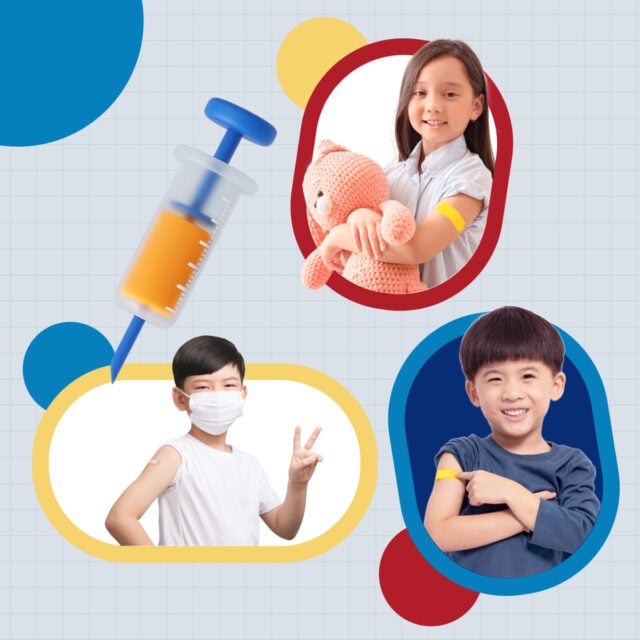Thailand’s rainy season is a joyful season for many types of viruses and bacteria, being the main cause of various diseases, especially in children who are at a very high risk of getting sick because their immune systems are not yet strong and complete. This can lead to infections and various diseases easily, as observed from many hospitals admitting a large number of children with illnesses during the rainy season, such as respiratory infections. Therefore, understanding the most common diseases in children during the rainy season, along with their significance, causes, and prevention methods, can help parents prevent these diseases in time and be aware of the symptoms.
1) Influenza
Influenza, or Influenza, is a disease common in people of all sexes and ages, almost all year round, because Thailand is in a tropical climate. However, it is more prevalent during the rainy season, which some years may see outbreaks, being a top cause of sudden fever illness. Doctors often diagnose children with a fever of 2 – 3 days without other clear symptoms as having Influenza, which sometimes may be misdiagnosed.
“Influenza differs from the common cold by causing complications that can be life-threatening. Main symptoms in children include fever, headache, body and muscle aches, cough, or sore throat, which children under the age of 5, elderly people aged 60 and above, or those with immunodeficiencies are at higher risk and may have more severe symptoms.”
Currently, Thailand continues to encounter new strains of influenza, including bird flu and the 2009 influenza, especially the latter which parents often worry about for their children. It is merely a mutated disease from the seasonal influenza virus but transmitted from animals like birds or pigs. Therefore, the severity of the disease is not much different, but it spreads faster because people have not previously been exposed to such diseases, making infection and sickness easier.
Nevertheless, vaccination against influenza should be done about 1 – 2 months before the global outbreak season every year and can be administered to children from the age of 6 months. The best prevention is for sick individuals to try to avoid spreading the infection to others, including wearing masks, washing hands, and eating hygienically, which can effectively prevent influenza.
2) Hand, Foot, and Mouth Disease
Hand, Foot, and Mouth Disease caused by viruses (Enterovirus 71, Coxsackie) can be found sporadically throughout the year, but more so in the rainy season. Symptoms in children include fever, rash, clear blisters on palms, soles, and mouth ulcers, including cheeks, tongue, gums, and some cases might also have rashes on legs and buttocks, common in children aged 6 months to 3 years (kindergarten to primary school). Symptoms usually resolve on their own within 3 – 10 days. The disease can be transmitted through coughing, sneezing, saliva, or feces, with an incubation period of 3 – 6 days. The virus can be found in saliva 2 – 3 days before symptoms appear until 1 – 2 weeks after symptoms.
“If caught, some children may have trouble eating and drinking due to severe mouth pain, to the extent of not even wanting to swallow their saliva, leading to dehydration. Therefore, do not let the child have too high a fever as it may lead to seizures. Some cases may have complications, especially children under the age of 5, such as encephalitis, meningitis. Parents should watch for symptoms, and if abnormal, must consult a doctor immediately.”
To prevent, parents should care for the child’s diet, drinking water, and if not necessary, should not let the child be in crowded places, and should bring their own water bottle or glass to school, as well as cultivating and training the child to use a serving spoon every meal whether at school or home.
3) Dengue Fever
Dengue Fever is a disease with “Aedes mosquitoes” as the disease vector, which can affect both children and adults, whether in Bangkok or provinces. Infected individuals will experience high fever for more than 3 days, redness of eyes and face, feeling weak, and abdominal pain.
“This disease is endemic all year round, especially in the rainy season, because the opportunity for water to stagnate is high. Therefore, a tell-tale sign that your child may have dengue fever is having a very high fever that does not subside with fever-reducing medication, headaches, sore behind the eye sockets, or muscle aches, red eyes, red face, red mouth, etc.”
Additionally, it can lead to liver inflammation, causing the patient to have abdominal pain, especially in the right rib cage area – the location of the liver. This is because the liver is enlarged. At the same time, there may be vomiting and dehydration, which if seen by a doctor in time, can predict that the child has symptoms consistent with dengue fever, and further tests will be conducted.
The best prevention is to not let mosquitoes bite and to eliminate breeding sites of Aedes mosquitoes. Do not wait for symptoms to become severe before consulting a doctor, such as having too high a fever, shock, or easy bleeding. Must rush the child to see a doctor immediately.
4) Chickenpox
Many families are familiar with this disease, as it is common and frequent, but often occurs in certain periods. When infected, it often spreads continuously, especially through contact with friends at school. Symptoms of the disease include fever, red rashes and clear vesicles appearing throughout the body, starting from the abdomen area spreading to the arms, legs, and face, followed by crust formation and potentially scarring, usually resolving on its own about 2 – 3 weeks.
“Try to keep the body strong because this disease does not occur according to age. Some cases occur in children, or some may occur in adults, which if occurring in adulthood, symptoms and blister formation can be more severe. Preventing by keeping children away from infected individuals, frequent hand washing, etc.”
Nevertheless, there are currently vaccines available for chickenpox, which are quite effective, starting from 1 year old and a booster shot at 4 years old, which is an additional vaccine and not yet a standard requirement for every child.
5) Diarrhea or Gastroenteritis
Diarrhea occurs due to inflammation of the intestines from rotavirus infection, which comes from toys, food, or personal items near children that are not clean. Especially young children who are unaware and do not understand hygiene, often putting toys or contaminated objects in their mouth unnoticed. Then, it is excreted through the patient’s feces, leading to easy outbreaks. Research has found that almost every child from birth to age 5 has been infected with this virus.
Rotavirus is the culprit behind gastroenteritis in infants and young children under 2 years of age, with statistics worldwide and in Thailand showing that rotavirus is a leading cause of children getting sick and dying from diarrhea, with about 600,000 deaths annually.
“Most symptoms found include diarrhea, vomiting, some cases with high fever, eating less, fretfulness, leading to dehydration. Therefore, breastfed infants should continue, which helps to a certain extent. And care for the cleanliness of eating and playing appropriately, should be clean. At the same time, avoid taking children to the nursery too early because large groups of children together can spread infection easily.”
Currently, there are effective preventative vaccines approved, consisting of 1 type of rotavirus and 5 types of rotavirus, which are oral vaccines (drops) that can be started in infants from about 6 – 12 weeks. The reason to start at this age is that in the early weeks, infants still receive immunity created from the placenta and breastfeeding. Building immunity against rotavirus should begin at about 2 months of age when children might start to encounter germs around them.
6) Invasive Pneumococcal Disease (IPD) and Pneumonia
Invasive Pneumococcal Disease (IPD) or what is known as Invasive Pneumococcal Disease (IPD) is a severe infection caused by bacteria called “pneumococcus” leading to bloodstream infections and meningitis, which is severe and can cause disability or death in children, especially in those under 2 years old.
If infected in the nervous system, such as meningitis, children will have high fever, severe headaches, nausea, vomiting, stiff neck, small children will show irritability, lethargy, and seizures. As for bloodstream infections, children will have a high fever, irritability. If severe, it may lead to shock and death. However, if such symptoms occur, it is crucial to quickly get medical help.
Furthermore, the “pneumococcus” bacteria is also a main cause of pneumonia or lung infection, with World Health Organization (WHO) and UNICEF assessments indicating that pneumonia is the leading cause of death amongst children under 5 years old globally, with up to 2 million deaths per year, which is more than AIDS, malaria, and measles combined.
“Currently, vaccines are administered to children under 2 years of age because they are at high risk of infection. In infants, the first shot should be given when they reach 2 months of age and continue at 4 months, 6 months, and 12 – 15 months. Young children under 5 years old with chronic diseases or immunodeficiencies are at high risk, hence vaccines are crucial for prevention. Breastfeeding and maintaining good hygiene are also important preventive measures.”
All children are prone to getting sick easily, especially during the rainy season. If the child shows unusual symptoms such as high fever, poor appetite, vomiting, easy fatigue, dehydration, or respiratory problems, such as frequent coughing, rapid breathing, it is vital to see a doctor immediately because early disease diagnosis increases the chance of recovery and reduces disease severity.
Diseases create discomfort for both children and parents alike. To prevent diseases, parents should pay attention to their child’s hygiene, whether it’s washing hands before eating, playing, and taking care of health. This is to prevent various diseases that may affect the child later. These are preliminary prevention methods that every family can practice at home.











